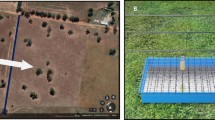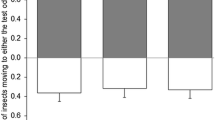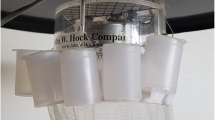Abstract
Volatile organic compounds derived from microbes recruit insects to carrion, shaping community assembly and ecological succession. The importance of individual volatiles and interactions between volatiles are difficult to assess in the field because of (1) the myriad compounds from decomposing animals and (2) the likelihood that complex volatile blends are important for the final approach to carrion. On the assumption that searching carrion-frequenting beetles may use simpler cues to orient at a distance, we employed a chemically-supplemented minimal trap that uses test chemicals associated with active decay to attract from a distance and a minimal carrion bait (a small fresh mouse carcass) to induce trap entry. Traps supplemented with both methyl thiolacetate (MeSAc) and dimethyl trisulfide (DMTS) attracted greater numbers of beetles including adult silphids (Necrophila americana and Oiceoptoma noveboracense) and the histerid Euspilotus assimilis than the combined totals of DMTS-only and MeSAc-only traps, demonstrating a synergism. The attraction of larval Necrophila americana to traps left in the field for less than 24 h suggests that larvae move between carrion sources. The use of such species for forensic applications requires caution.


Similar content being viewed by others
Data availability
Data are available through Digital Commons (University of Connecticut) and the Open Science Framework.
Code availability
Not applicable.
References
Anderson RS (1982) Resource partitioning in the carrion beetle (Coleoptera: Silphidae) fauna of southern Ontario: ecological and evolutionary considerations. Canad J Zool 60:1314–1325
Anderson GS (2015) Human decomposition and forensics. In: Benbow M, Tomberlin J, Tarone A (eds) Carrion ecology, evolution, and their applications. CRC Press, Boca Raton, pp 556–575
Anderson RS, Peck SB (1985) The insects and arachnids of Canada: Part 13. Canadian Government Publishing Centre, Ottawa
Armstrong P, Nizio KD, Perrault KA, Forbes SL (2016) Establishing the volatile profile of pig carcasses as analogues for human decomposition during the early postmortem period. Heliyon 2:e00070
Bala M (2015) Beetles and forensic entomology: a comprehensive review. J Entomol Res 39:293–302
Battán Horenstein M, Linhares A (2011) Seasonal composition and temporal succession of necrophagous and predator beetles on pig carrion in central Argentina. Med Vet Entomol 25:395–401
Borg-Karlson A, Englund FO, Unelius CR (1994) Dimethyl oligosulphides, major volatiles released from Sauromatum guttatum and Phallus impudicus. Phytochemistry 35:321–323
Brodie BS, Babcock T, Gries R, Benn A, Gries G (2016) Acquired smell? Mature females of the common green bottle fly shift semiochemical preferences from feces feeding sites to carrion oviposition sites. J Chem Ecol 42:40–50
Byers JA (2015) Earwigs (Labidura riparia) mimic rotting-flesh odor to deceive vertebrate predators. Sci Nat 102:38
Cammack J, Pimsler M, Crippen T, Tomberlin J (2015) Chemical ecology of vertebrate carrion. In: Benbow ME, Tomberlin JK, Tarone AM (eds) Carrion ecology, evolution, and their applications. CRC Press, Boca Raton, pp 187–212
Cardé, R, Charlton, R (1984) Olfactory sexual communication in Lepidoptera: Strategy, sensitivity and selectivity. In: Insect Communication, 12th Symposium of the Royal Entomological Society of London 241–265
Carter DO, Yellowlees D, Tibbett M (2007) Cadaver decomposition in terrestrial ecosystems. Naturwissenschaften 94:12–24
Charabidze D, Vincent B, Pasquerault T, Hedouin V (2016) The biology and ecology of Necrodes littoralis, a species of forensic interest in Europe. Int J Legal Med 130:273–280
Chaudhury M, Zhu J, Skoda S (2017) Physical and physiological factors influence behavioral responses of Cochliomyia macellaria (Diptera: Calliphoridae) to synthetic attractants. J Econ Entomol 110:1929–1934
Cosse AA, Baker TC (1996) House flies and pig manure volatiles: wind tunnel behavioral studies and electrophysiological evaluations. J Agric Entomol 13:301–317
Crippen TL, Benbow ME, Pechal JL (2015) Microbial interactions during carrion decomposition. In: Benbow M, Tomberlin J, Tarone A (eds) Carrion ecology, evolution, and their applications. CRC Press, Boca Raton, pp 31–62
Cruise A, Watson DW, Schal C (2018) A novel passive sampling technique for collecting adult necrophilous insects arriving at neonate pig carcasses. Environ Entomol 47:1573–1581
Cruise A, Kakumanu ML, Watson DW, Schal C (2020) Effects of carrion relocation on the succession of newly arriving adult necrophilous insects. J Med Entomol 57:164–172
Davis TS, Crippen TL, Hofstetter RW, Tomberlin JK (2013) Microbial volatile emissions as insect semiochemicals. J Chem Ecol 39:840–859
Dekeirsschieter J, Verheggen F, Gohy M, Hubrecht F, Bourguignon L, Lognay G, Haubruge E (2009) Cadaveric volatile organic compounds released by decaying pig carcasses (Sus domesticus L.) in different biotopes. Forensic Sci Int 189:46–53
Dekeirsschieter J, Frederickx C, Lognay G, Brostaux Y, Verheggen FJ, Haubruge E (2013) Electrophysiological and behavioral responses of Thanatophilus sinuatus Fabricius (Coleoptera: Silphidae) to selected cadaveric volatile organic compounds. J Forensic Sci 58:917–923
Fancher J, Aitkenhead-Peterson J, Farris T, Mix K, Schwab A, Wescott D, Hamilton M (2017) An evaluation of soil chemistry in human cadaver decomposition islands: potential for estimating postmortem interval (PMI). Forensic Sci Int 279:130–139
Forbes SL, Carter DO (2015) Processes and mechanisms of death and decomposition of vertebrate carrion. In: Benbow M, Tomberlin J, Tarone A (eds) Carrion ecology, evolution, and their applications. CRC Press, Boca Raton, pp 13–30
Greene GL (1996) Rearing techniques for Creophilus maxillosus (Coleoptera: Staphylinidae), a predator of fly larvae in cattle feedlots. J Econ Entomol 89:848–851
Hammack L (2001) Single and blended maize volatiles as attractants for diabroticite corn rootworm beetles. J Chem Ecol 27:1373–1390
Janzen DH (1977) Why fruit rots, seeds mold and meat spoils. Am Nat 111:691–713
Johnson S, Jürgens A (2010) Convergent evolution of carrion and faecal scent mimicry in fly-pollinated angiosperm flowers and a stinkhorn fungus. S Afr J Bot 76:796–807
Jordan HR, Tomberlin JK, Wood TK, Benbow ME (2015) Interkingdom ecological interactions of carrion decomposition. In: Benbow M, Tomberlin J, Tarone A (eds) Carrion ecology, evolution, and their applications. CRC Press, Boca Raton, pp 433–459
Jürgens A, Shuttleworth A (2015) Carrion and dung mimicry in plants. In: Benbow M, Tomberlin J, Tarone A (eds) Carrion ecology, evolution, and their applications. CRC Press, Boca Raton, pp 361–386
Kalinova B, Podskalska H, Ruzicka J, Hoskovec M (2009) Irresistible bouquet of death-how are burying beetles (Coleoptera: Silphidae: Nicrophorus) attracted by carcasses. Naturwissenschaften 96:889–899
Kite GC, Hetterscheid WL (2017) Phylogenetic trends in the evolution of inflorescence odours in Amorphophallus. Phytochemistry 142:126–142
Landolt P, Suckling D, Judd G (2007) Positive interaction of a feeding attractant and a host kairomone for trapping the codling moth, Cydia pomonella (L.). J Chem Ecol 33:2236–2244
Lutz L, Amendt J, Moreau G (2018) Carcass concealment alters assemblages and reproduction of forensically important beetles. Forensic Sci Int 291:124–132
Marcin Ś (2011) Insect succession on carrion: seasonality, habitat preference and residency of histerid beetles (Coleoptera: Histeridae) visiting pig carrion exposed in various forests (Western Poland). Pol J Ecol 59:787–797
Martin C, Minchilli D, Francis F, Verheggen F (2020) Behavioral and electrophysiological responses of the fringed larder beetle Dermestes frischii to the smell of a cadaver at different decomposition stages. Insects 11:238
Meng L, Wu C, Wicklein M, Kaissling K, Bestmann H (1989) Number and sensitivity of three types of pheromone receptor cells in Antheraea pernyi and A. polyphemus. J Comp Physiol A 165:139–146
Merritt RW, De Jong GD (2015) Arthropod communities in terrestrial environments. In: Benbow M, Tomberlin J, Tarone A (eds) Carrion ecology, evolution, and their applications. CRC Press, Boca Raton, pp 65–92
Midgley JM, Richards CS, Villet MH (2009) The utility of Coleoptera in forensic investigations. In: Amendt J, Goff M, Campobasso C, Grassberger M (eds) Current concepts in forensic entomology. Springer, Dordrecht, pp 57–68
Nilssen AC, Tømmerås BÅ, Schmid R, Evensen SB (1996) Dimethyl trisulphide is a strong attractant for some calliphorids and a muscid but not for the reindeer oestrids Hypoderma tarandi and Cephenemyia trompe. Entomol Exp Appl 79:211–218
Ohsugi T, Nishida R, Fukami H (1985) Oviposition stimulant of Papilio xuthus, a citrus-feeding-Swallowtail butterfly. Agric Biol Chem 49:1897–1900
Payne JA (1965) A summer carrion study of the baby pig Sus scrofa. Ecology 46:592–602
Podskalska H, Ruzicka J, Hoskovec M, Salek M (2009) Use of infochemicals to attract carrion beetles into pitfall traps. Entomol Exper Appl 132:59–64
Ratcliffe BC (1996) The carrion beetles (Coleoptera: Silphidae) of Nebraska. University of Nebraska State Museum, Lincoln
Recinos-Aguilar YM, García-García MD, Malo EA, Cruz-López L, Rojas JC (2019) The colonization of necrophagous larvae accelerates the decomposition of chicken carcass and the emission of volatile attractants for blowflies (Diptera: Calliphoridae). J Med Entomol 56:1590–1597
Reed HBJ (1958) A study of dog carcass communities in Tennessee with special reference to the insects. Am Midl Nat 59:213–245
Riffell JA, Shlizerman E, Sanders E, Abrell L, Medina B, Hinterwirth AJ, Kutz JN (2014) Flower discrimination by pollinators in a dynamic chemical environment. Science 344:1515–1518
SAS Institute Inc (2007) JMP statistics and graphics guide v. 7. SAS Institute, Inc., Cary
Savarie PJ, Clark L (2006) Evaluation of bait matrices and chemical lure attractants for brown tree snakes. In: Proceedings of the 22nd Vertebrate Pest Conference, pp 483–488
Schlyter F, Loqvist J, Byers J (1987) Behavioural sequence in the attraction of the bark beetle Ips typographus to pheromone sources. Physiol Entomol 12:185–196
Shirasu M, Fujioka K, Kakishima S, Nagai S, Tomizawa Y, Tsukaya H, Murata J, Manome Y, Touhara K (2010) Chemical identity of a rotting animal-like odor emitted from the inflorescence of the titan arum (Amorphophallus titanum). Biosci Biotechnol Biochem 74:2550–2554
Shivik JA, Clark L (1999) The development of chemosensory attractants for brown tree snakes. In: Johnston RE, Müller-Schwarze D, Sorensen PW (eds) Advances in chemical signals in vertebrates. Springer, Boston, pp 649–654
Silbering AF, Galizia CG (2007) Processing of odor mixtures in the Drosophila antennal lobe reveals both global inhibition and glomerulus-specific interactions. J Neurosci 27:11966–11977
Strickland MS, Wickings K (2015) Carrion effects on belowground communities and consequences for soil processes. In: Benbow ME, Tomberlin JK, Tarone AM (eds) Carrion ecology, evolution, and their applications. CRC Press, Boca Raton, pp 93–106
Summerlin J, Fincher G, Meola S (1989) Laboratory observations on the life cycle of Euspilotus assimillis (Coleoptera: Histeridae). J Entomol Sci 24:496–499
Tabor KL, Fell RD, Brewster CC (2005) Insect fauna visiting carrion in Southwest Virginia. Forensic Sci Int 150:73–80
Trumbo ST (1990) Reproductive success, phenology, and biogeography of burying beetles (Silphidae, Nicrophorus). Am Midl Nat 124:1–11
Trumbo ST, Steiger S (2020) Finding a fresh carcass: bacterially-derived volatiles and burying beetle search success. Chemoecology. https://doi.org/10.1101/2020.01.25.919696 ((in press))
Trumbo ST, Philbrick PKB, Stökl J, Steiger S (2020) Burying beetles adaptively manipulate information broadcast from a microbial community. Am Nat (in press)
Tyc O, Zweers H, de Boer W, Garbeva P (2015) Volatiles in inter-specific bacterial interactions. Front Microbiol 6:1412
Verheggen F, Perrault KA, Megido RC, Dubois LM, Francis F, Haubruge E, Forbes SL, Focant J, Stefanuto P (2017) The odor of death: an overview of current knowledge on characterization and applications. Bioscience 67:600–613
Verschut TA, Carlsson MA, Hambäck PA (2019) Scaling the interactive effects of attractive and repellent odours for insect search behaviour. Sci Rep 9:1–8
von Hoermann C, Ruther J, Ayasse M (2012) The attraction of virgin female hide beetles (Dermestes maculatus) to cadavers by a combination of decomposition odour and male sex pheromones. Front Zool 9:18
von Hoermann C, Steiger S, Müller JK, Ayasse M (2013) Too fresh is unattractive! The attraction of newly emerged Nicrophorus vespilloides females to odour bouquets of large cadavers at various stages of decomposition. PLoS ONE 8:e58524
von Hoermann C, Ruther J, Ayasse M (2016) Volatile organic compounds of decaying piglet cadavers perceived by Nicrophorus vespilloides. J Chem Ecol 42:756–767
Watson E, Carlton C (2005) Succession of forensically significant carrion beetle larvae on large carcasses (Coleoptera: Silphidae). Southeast Nat 4:335–347
Webster B, Cardé RT (2017) Use of habitat odour by host-seeking insects. Biol Rev 92:1241–1249
Wee SL, Tan SB, Jürgens A (2018) Pollinator specialization in the enigmatic Rafflesia cantleyi: a true carrion flower with species-specific and sex-biased blow fly pollinators. Phytochemistry 153:120–128
Wilson DS, Knollenberg WG, Fudge J (1984) Species packing and temperature dependent competition among burying beetles (Silphidae, Nicrophorus). Ecol Entomol 9:205–216
Wilson JK, Kessler A, Woods HA (2015) Noisy communication via airborne infochemicals. Bioscience 40:1–11
Yan G, Liu S, Schlink AC, Flematti GR, Brodie BS, Bohman B, Greeff JC, Vercoe PE, Hu J, Martin GB (2018) Behavior and electrophysiological response of gravid and non-gravid Lucilia cuprina (Diptera: Calliphoridae) to carrion-associated compounds. J Econ Entomol 111:1958–1965
Yoho KC (2019) Necrophilous insect attraction to cadaveric volatile organic compounds. M.Sc. thesis, Purdue University, West Lafayette
Zito P, Sajeva M, Raspi A, Dötterl S (2014) Dimethyl disulfide and dimethyl trisulfide: so similar yet so different in evoking biological responses in saprophilous flies. Chemoecology 24:261–267
Acknowledgements
We thank Alfred Newton (staphylinids), Armin Moczek and Anna Macagno (scarabs) for their assistance with insect identification. Sandra Steiger kindly reviewed the manuscript. The Southern Connecticut Regional Water Authority and the Flanders Preserve granted permission for field experiments. The research was supported by the University of Connecticut Research Foundation.
Funding
This work was supported by the University of Connecticut Research Foundation.
Author information
Authors and Affiliations
Contributions
ST and JD carried out the research and analyzed the data. ST planned and designed the research and wrote the manuscript. Both authors read and approved the final manuscript.
Corresponding author
Ethics declarations
Conflict of interest
The authors declare no conflicts of interest.
Ethics approval
This research is covered under IACUC-2 guidelines (E16-006) administered by The University of Connecticut (#A3124-01).
Consent to participate
Not applicable.
Consent for publication
The authors consent to publication.
Additional information
Communicated by Günther Raspotnig.
Rights and permissions
About this article
Cite this article
Trumbo, S.T., Dicapua, J.A. A synergism between dimethyl trisulfide and methyl thiolacetate in attracting carrion-frequenting beetles demonstrated by use of a chemically-supplemented minimal trap. Chemoecology 31, 79–87 (2021). https://doi.org/10.1007/s00049-020-00330-4
Received:
Accepted:
Published:
Issue Date:
DOI: https://doi.org/10.1007/s00049-020-00330-4




